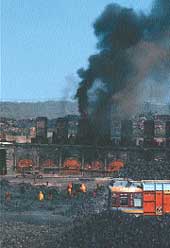
Fire sparks controversy
The huge forest fire that swept New South Wales smoked out into the open a debate over the government's weak fire fighting strategy.

The huge forest fire that swept New South Wales smoked out into the open a debate over the government's weak fire fighting strategy.

A new project seeks to examine the environmental degradation due to development in Kochi

A symbiosis between bird and man provides a welcome winter home for the blacknecked crane, rediscovered in India after four decades

An audit of the earth addresses the growing concern that the costs of environmental degradation are actually becoming a serious threat to sustained welfare
From pugmarks to high-tech equipment like satellite imagery and camera-traps. That's how census on wild animals in Jammu and Kashmir is graduating. Come March, and the state Government will undertake two scientific censuses on three wild animals: the highly-endangered hangul, also called the Kashmir stag, the common leopard and the Asiatic black bear, also known as Himalayan black bear. To be conducted in collaboration with the Central Government, the censuses will also get expert help from the Wildlife Institute of India, Dehradun. J&K Chief Wildlife Warden A K Srivastava says, "While one census will be on the endangered hangul, found only in Kashmir, the other will focus on the common leopard and the Asiatic black bear.' The Kashmir stag census will be utilised to protect the endangered animal, and the other will be used to deal with the increasing incidents of the man-animal conflicts in the state. Srivastava says the earlier censuses conducted by the state Government were not accurate as these were carried out "on the basis of their pugmarks'. "But the new censuses will be carried out, using the most high-tech equipment like satellite imagery and camera-traps,' he adds. Cameras will be put on trees in the forest areas, which will trap the movement of wild animals, recording their actual number with the help of satellite imagery. The Centre has agreed in principle to fund the census projects. "In Jammu, experts from the Wildlife Institute of India will hold a three-day training workshop for divisional forest officers and range officers of the state forest and wildlife departments,' adds Srivastava. While the hangul is not harmful, the other two have caused man-animal conflicts in the state over the past two years, killing over three dozen and injuring more than 200 people. While the hangul census will mainly focus on the Kashmir valley, the other one will cover various areas
There is so much about rural India that escapes notice that one more area of neglect will not break the camel s back. I am talking about the crisis of fodder for livestock. A grim silence surrounds
The Malaysian government would help its neighbours to fight the haze blanketing part of the Southeast Asian region to ensure non-disruption of the Commonwealth Games. Prime minister Mahathir
MOTIVATED by the need for a holistic understanding of the impact of human activity on the earth's natural phenomena, scientists in the last decade have been studying the earth as an entire system,
Indian Ministry of Environment and Forests and Centre for Science and Environment side event at COP 17: The imperative of equity for an effective climate agreement Organizers: Ministry of Environment
"What are we supposed to feel when a sarkari animal carries our children away? Are we still supposed to love the animal and the sarkar?" This plea by an activist working with poor people living in
Union minister of environment and forests T R Baalu proudly proclaimed at a review meeting that the Charter on Corporate Responsibility for Environmental Protection (crep) is a huge hit, with almost

UP To half of the world's biological wealth is threatened with extinction if the current protective measures are not extended to cover more land area. This is the conclusion of a report,

The Rajasthan and Haryana governments feel threatened by the Centre's move to stop industrial, mining and quarrying activity in the Aravalli region. Environmentalists, on the other hand, applaud the move

Can bamboo become the basis of a thriving industry? Can the northeast cash in the most?

The entry of large business houses into the Sundarbans is not only jeopardising the interests of local fisherfolk, but also causing major ecological damage.

It was the Stockholm conference, held exactly 20 years ago, which put environmental issues on the global agenda for the first time. But the contours of environmental negotiapons have changed a great deal from those early days

A hydro electric project threatens Keibul Latnjao, the world's only floating sanctuary

Can protected areas survive the multitude of pressures without the participation of people? Neena Singh explores the issue
The Rs. 35,000-crore Mangalore Special Economic Zone Project appears to have suffered a setback as a Central committee of experts has advised the Ministry of Environment and Forests against going ahead with Phase II of the project, according to information available on the website of the Ministry. At a meeting in New Delhi on February 27 and February 28 to discuss the issue of environment clearance for the project, the Expert Committee on Infrastructure and Miscellaneous Projects said, "The project should be restricted to only Phase I.' Phase I covers 1,800 acres of land which has been acquired by the promoters of the project. Land (2,035 acres) for Phase II is yet to be acquired. The company, Mangalore Special Economic Zone Limited, has been facing opposition from various farmers' organisations and environmentalists as far as Phase II is concerned. The committee has come to the conclusion based on the recommendations of another sub-committee constituted by the Ministry which was entrusted with the responsibility of visiting Mangalore and inspecting the villages notified for the project. The inspection committee was sent to Mangalore after the Ministry took cognisance of the protests and objections against the proposed project. At the New Delhi meeting, the committee said that in view of the protests, the company should confine itself to Phase I of the project. However, the promoters of the project have requested the Ministry to consider the whole project (Phases I and II) saying that the Environmental Impact Assessment has been done for infrastructure on 2,035 acres of land as well. Guarding against any complacency, Lawrence D'Cunha, secretary of the Krishi Bhoomi Samrakshana Samiti, said, "This is only the first step towards victory. We are going to scale up our agitation and not relent until our lands are de-notified.' The samiti represents the four villages of Permude, Thenka Ekkaru, Delantha Bettu and Kuthethoor which have been notified for the second phase of the project.

How the villagers of Pujara Ki Chowki foiled hamhanded attempts of the state forest department to force start a plantation on a forest already protected and nurtured by the people